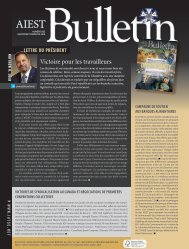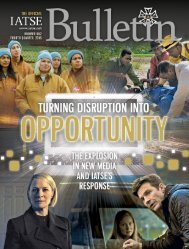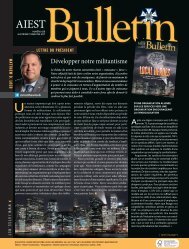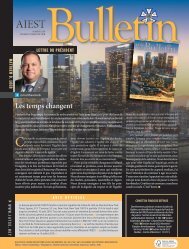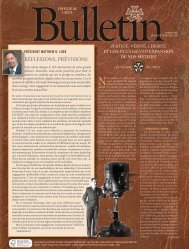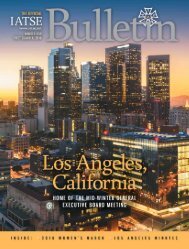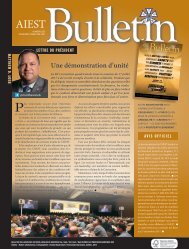The Official Bulletin - Quarter 2, 2019
- No tags were found...
Create successful ePaper yourself
Turn your PDF publications into a flip-book with our unique Google optimized e-Paper software.
MOTION PICTURE<br />
<strong>The</strong> King Kong of the motion picture industry goes by<br />
the name of “<strong>The</strong> Volume” because it uses a new technology<br />
known as “volumetric capture.”<br />
“<strong>The</strong> Volume utilizes game engine technology to display<br />
live video in a dome,” said International Vice President and Department<br />
Director for Motion Picture and TV Production Michael<br />
F. Miller, Jr. “It’s a 360-degree LED dome that works like<br />
an electronic green screen with the images already projected<br />
onto it, and the actors, directors and crew can see the background<br />
as they film.<br />
“If you’re filming a scene in the cockpit of a spaceship, the<br />
LED wall displays the remainder of the spaceship and the quality<br />
of the picture is such that it’s impossible to tell you’re not<br />
actually in a complete spaceship,” Miller explained. “<strong>The</strong> actor<br />
and the scenery move together in real time.”<br />
<strong>The</strong> Volume has become so popular, virtually all of the major<br />
motion picture studios either have opened one or announced<br />
plans to do so. Sony, for example, will open its Innovation Studios<br />
using the same technology this fall. And other players are<br />
getting involved. Intel Studios has opened what it calls “the<br />
world’s largest, most advanced volumetric video capture and<br />
creation facility” at 10,000 square feet.<br />
“<strong>The</strong> quality of the image is so good now, you cannot tell<br />
the difference between a scene filmed in <strong>The</strong> Volume and a<br />
scene filmed on location,” said Scott Bernard, Business Agent<br />
of Local 695 Audio and Video Engineers in Los Angeles, noting<br />
that it not only works for science fiction, but for any production<br />
meant to be anywhere on Earth.<br />
“You can take 1,200 individual stills from a location, load<br />
them into a computer, and then display the meshed images on<br />
a 360 degree wall and ceiling,” Bernard said. “You can make it<br />
day or night as you wish. <strong>The</strong> cameras can capture any angle.<br />
And as the camera moves, the images behind the actors move<br />
with it. Unlike a green screen, it gives the actors the environment<br />
to react to and create their own reality.”<br />
This makes it possible to set a scene in Venice, the Himalayas,<br />
the Sahara or anywhere else while shooting in a dome in<br />
Los Angeles and viewers will not be able to tell the difference.<br />
<strong>The</strong> impact on film crews’ work is significant. “This is the<br />
ongoing evolution of the Process Shot, which has been around<br />
for decades,” Bernard said. “You don’t have to spend money<br />
in post to recreate a scenic background and develop a composite<br />
image, because you’re doing it all in one take as you’re<br />
shooting. I don’t think this will replace all location shooting or<br />
green screen production, but it’s another tool that gives the<br />
director and producer extra flexibility.”<br />
<strong>The</strong> extent to which <strong>The</strong> Volume will come to dominate film<br />
production is unclear at this point. “Some employers think it<br />
will save time and money because they don’t have to take a<br />
full crew to a location,” he said. “<strong>The</strong>y think they can hire fewer<br />
people. And it’s a more controlled environment. But I’m not so<br />
sure. I think it’s going to create new technical jobs. <strong>The</strong> video<br />
and engineering demands fall right into IATSE’s wheelhouse.<br />
IA Video Engineers have vast experience with video playback,<br />
front and rear projection, video walls and green screen technology,<br />
all of which lends itself to what is needed for volumetric<br />
capture.<br />
“So we’re doing two things,” he noted. “One is we’re being<br />
vigilant with our employers to ensure that all the new technological<br />
work falls under IATSE jurisdiction. And we’re being<br />
proactive about training to ensure our members are up to<br />
22 OFFICIAL BULLETIN






